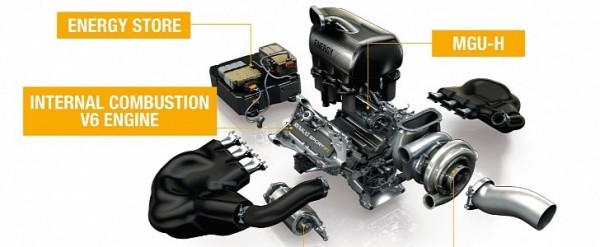
The engine in Formula 1 cars is a turbocharged direct fuel injection unit that develops in the 700 horsepower range. ERS adds an extra 160 horsepower, making the engine just as potent as the 2.4-liter V8 used between 2006 and 2013, while burning 35 percent less fuel.
When the 2.4-liter engine was in use, it was paired to a Kinetic Energy Recovery System (KERS) that has been introduced ever since 2009. KERS was used to capture waste energy created while braking and transform it into electrical energy. It produced an additional 80 horsepower.
The evolution of engineering makes KERS a precursor of the current system. Unlike KERS, ERS comprises two motor generator units (MGU-K and MGU-H ) that convert both mechanical and heat energy to electrical energy and vice versa. An Energy Store (ES) unit and control electronics complete the system. MGU-K
MGU-K stands for Motor Generator Unit Kinetic and is, in fact, an updated version of KERS. A variant of it is what can be found in today’s commercial hybrid cars.
It is used to convert kinetic energy generated under braking into electricity, after storing it in the ES system. MGU-K’s energy recovering capabilities are limited to 2 Megajoules of energy per lap.
Because it is connected to the crankshaft through the timing gears, when the driver of the car accelerates, it also acts as a motor, providing an additional 160 horsepower, that can be used for 33 seconds per lap.MGU-H
MGU-H is short for Motor Generator Unit Heat and is a system that can for now be found more in racing than in car manufacturing (when present, it is called e-turbo).
It is connected to the turbocharger of the engine, between the turbine and the compressor, and captures the heat energy from exhaust gases and turns it into electrical energy.
It also acts as a control system for the turbo, speeding or slowing it depending on the requirements of the driver. With the use of the MGU-H system, Formula 1 cars have virtually zero turbo lag.
The energy MGU-H stores are used by the MGU-K. The amount of power the MGU-H is capable of recovering is huge, meaning it can provide up to 4 Megajoules back to the MGU-K. That’s ten times more that it was possible with KERS.RACING
Having pretty much the exact amount of power coming from equally-created engines means the drivers are the biggest players when it comes to influencing the outcome of a race.
In all, Formula 1 considers there are six separate elements powering the cars racing during Grand Prix races: the engine, the turbocharger, the MGU-K, the MGU-H, the Energy Store and the control electronics.
Each of the drivers is entitled to using only four of each of these systems per season. Using more than four of any one component during a race will lead to the driver being penalized on the grid from five to ten places.
Drivers are capable of switching to different power unit settings or dictate how much energy ERS recovers through steering wheel controls.
Having ERS allows the driver to either go for a very fast lap time by going full power or saving energy to overtake at critical points while giving up on setting record lap times.
When announcing the new engine rules, Formula 1 officials say the MGU-H component of the ERS system is currently the most complex and costly element of the Formula 1 car.








